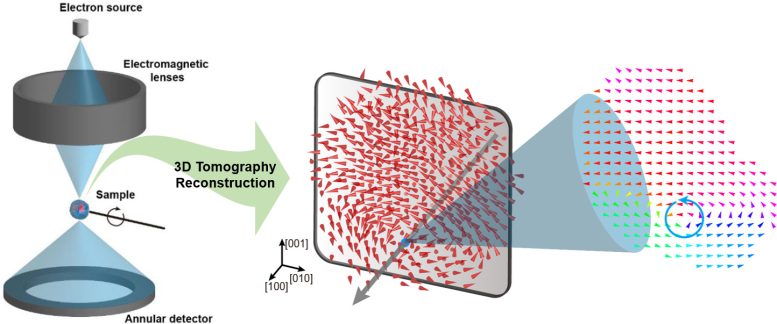博文
20年的难题解决了:物理学家揭示了零维铁电体的三维漩涡
 精选
精选
||
20年的难题解决了:物理学家揭示了零维铁电体的三维漩涡
诸平
据韩国科学技术院(Korea Advanced Institute Of Science And Technology简称KAIST, Daejeon, Republic of Korea)2024年6月2日提供的消息,20年的难题解决了:物理学家揭示了零维铁电体的“三维漩涡”(20-Year-Old Puzzle Solved: Physicists Reveal the “Three-Dimensional Vortex” of Zero-Dimensional Ferroelectrics)。
一个由KAIST领导的研究小组成功地展示了铁电纳米颗粒内部的三维极化分布,为先进的存储设备铺平了道路,这些设备的存储数据量是当前技术的1万倍以上。相关研究结果于2024年5月8日已经在《自然通讯》(Nature Communications)杂志网站发表——Chaehwa Jeong, Juhyeok Lee, Hyesung Jo, Jaewhan Oh, Hionsuck Baik, Kyoung-June Go, Junwoo Son, Si-Young Choi, Sergey Prosandeev, Laurent Bellaiche, Yongsoo Yang. Revealing the three-dimensional arrangement of polar topology in nanoparticles. Nature Communications 2024, 15, Article number: 3887. DOI: 10.1038/s41467-024-48082-x. Published: 08 May 2024. https://www.nature.com/articles/s41467-024-48082-x
参与此项研究的除了来自有来自KAIST的研究人员之外,还有来自美国劳伦斯·伯克利国家实验室(Lawrence Berkeley National Laboratory, Berkeley, CA, USA)、韩国基础科学研究院{Korea Basic Science Institute (KBSI), Seoul, Republic of Korea}、韩国浦项科技大学{Pohang University of Science and Technology (POSTECH), Pohang, Republic of Korea}、韩国首尔国立大学(Seoul National University, Seoul, Republic of Korea)、韩国基础科学研究所{Institute for Basic Science (IBS), Pohang, Republic of Korea}、美国阿肯色大学(University of Arkansas, Fayetteville, AR, USA)的研究人员。
不需要外部磁场而保持独立磁化的材料被称为铁磁体(ferromagnets)。同样,铁电体(ferroelectrics)可以在没有任何外部电场的情况下自行保持极化状态,相当于铁磁体的电等效(electrical equivalent)。
众所周知,当铁磁体缩小到纳米尺寸低于一定阈值时,就会失去磁性。当铁电体同样在各个方向上都做得非常小(即,成零维结构,如纳米颗粒)会发生什么,这一直是一个有争议的话题。
韩国科学技术院物理系(Department of Physics at KAIST )杨永洙博士(Dr. Yongsoo Yang)领导的研究小组通过与浦项科技大学(POSTECH)、首尔国立大学(SNU)、韩国基础科学研究院(KBSI)、美国劳伦斯·伯克利国家实验室(LBNL)和阿肯色大学的国际合作研究,首次通过实验阐明了铁电纳米颗粒内部的三维涡状极化分布。
大约20年前,劳伦·贝尔莱彻(Laurent Bellaiche)教授(目前在美国阿肯色大学)和他的同事们从理论上预测,铁电纳米点内部可能会出现一种独特的极化分布形式,以环形漩涡的形式排列。他们还表示,如果能适当地控制这种涡流分布,可以应用于比现有存储器容量大1万倍以上的超高密度存储器。然而,由于难以测量铁电纳米结构内的三维极化分布,实验尚未得到澄清。
电子断层扫描的先进技术(Advanced Techniques in Electron Tomography)
韩国科学技术院(KAIST)的研究小组通过实施一种名为原子电子断层扫描(atomic electron tomography)的技术,成功地解决了这个长达20年的挑战。这项技术的工作原理是,从多个倾斜角度获取纳米材料的原子分辨率透射电子显微镜图像,然后使用先进的重建算法将它们重建成三维结构。电子断层扫描基本上可以理解为与医院中使用的CT扫描相同的方法,以三维方式查看内部器官;KAIST团队利用单原子水平的电子显微镜,对纳米材料进行了独特的改造。
利用原子电子断层扫描,研究小组在三维空间上完全测量了钛酸钡(BaTiO3)纳米颗粒(一种众所周知的铁电材料)内阳离子原子的位置。从精确确定的三维原子排列,他们能够在单原子水平上进一步计算内部的三维偏振分布。对极化分布的分析首次在实验上揭示了拓扑极化顺序,包括涡旋(vortices)、反涡旋(anti-vortices)、天旋子(skyrmions)和布洛赫点(Bloch point),出现在0维铁电体内部,正如20年前理论上预测的那样。此外,还发现内部旋涡的数量可以根据其大小进行控制。
谢尔盖·普罗桑迪夫教授(Prof. Sergey Prosandeev)和劳伦·贝尔莱彻教授(他们在20年前与其他同事在理论上提出了极涡排序)加入了这次合作,并进一步证明了实验得到的涡旋分布结果与理论计算相一致。
通过控制这些极化分布的数量和方向,有望将其应用于下一代高密度存储器中,在相同尺寸的器件中存储的信息量是现有器件的1万倍以上。
领导这项研究的杨永洙博士解释了结果的意义:“这一结果表明,单独控制铁电体的大小和形状,而不需要调整衬底或周围环境的影响,如外延应变(epitaxial strain),可以在纳米尺度上操纵铁电漩涡或其他拓扑秩序。进一步的研究可以应用于下一代超高密度存储器的开发。”
该研究主要由韩国政府{Korean Government (MSIT)}资助的韩国国家研究基金会(National Research Foundation of Korea简称NRF)资助{National Research Foundation of Korea (NRF) Grants funded by the Korean Government (MSIT) (No. 2020R1C1C1006239 and RS-2023-00208179)}。但是,也得到了韩国科学技术院(KAIST)奇点教授项目(KAIST singularity professor program)、基础科学研究计划{Basic Science Research Program (2020R1A4A1018935)}、浦项科技大学-三星机电合作研究中心(POSTECH-Samsung ElectroMechanics Cooperative Research Center);美国海军研究局(ONR Grant No. N00014-21-1-2086)、美国国防部范内瓦·布什教员奖学金{Vannevar Bush Faculty Fellowship (VBFF) Grant No. N00014-20-1-2834 from the Department of Defense}以及美国陆军研究处{Army Research Office简称ARO Grant No. W911NF-21-2-0162 (ETHOS)}的资助或支持。
上述介绍,仅供参考。欲了解更多信息,敬请注意浏览原文或者相关报道。
In the early 2000s, low dimensional ferroelectric systems were predicted to have topologically nontrivial polar structures, such as vortices or skyrmions, depending on mechanical or electrical boundary conditions. A few variants of these structures have been experimentally observed in thin film model systems, where they are engineered by balancing electrostatic charge and elastic distortion energies. However, the measurement and classification of topological textures for general ferroelectric nanostructures have remained elusive, as it requires mapping the local polarization at the atomic scale in three dimensions. Here we unveil topological polar structures in ferroelectric BaTiO3 nanoparticles via atomic electron tomography, which enables us to reconstruct the full three-dimensional arrangement of cation atoms at an individual atom level. Our three-dimensional polarization maps reveal clear topological orderings, along with evidence of size-dependent topological transitions from a single vortex structure to multiple vortices, consistent with theoretical predictions. The discovery of the predicted topological polar ordering in nanoscale ferroelectrics, independent of epitaxial strain, widens the research perspective and offers potential for practical applications utilizing contact-free switchable toroidal moments.
https://blog.sciencenet.cn/blog-212210-1436878.html
上一篇:吃植物,战胜癌症:新的研究表明蔬菜可以降低患前列腺癌的风险
下一篇:全球开创性研究发现21种新型激光材料

